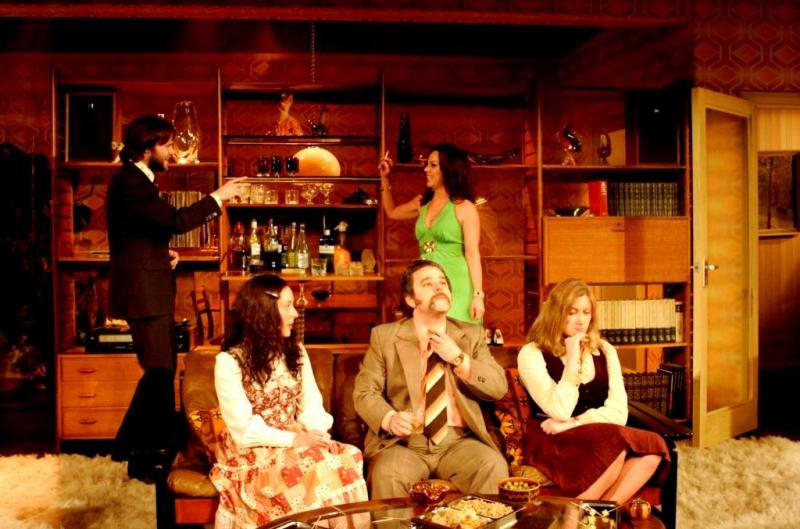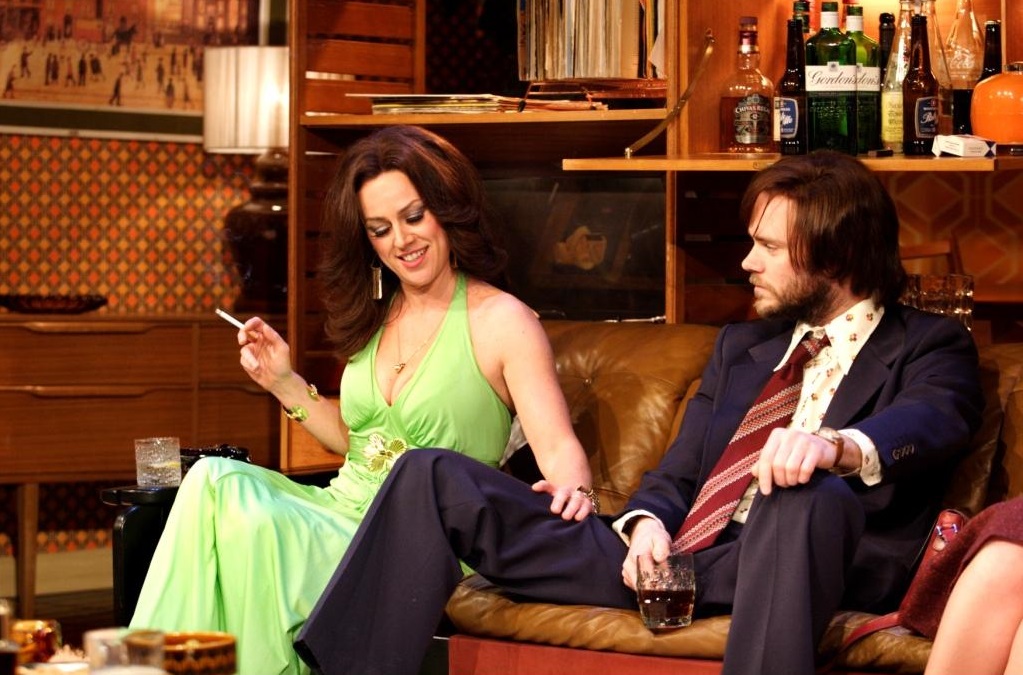Abigail's Party, Menier Chocolate Factory | reviews, news & interviews
Abigail's Party, Menier Chocolate Factory
Abigail's Party, Menier Chocolate Factory
Mike Leigh's Seventies warhorse cannot quite escape the long shadow of its original incarnation

Mike Leigh’s Abigail’s Party: comedy classic or Who’s Afraid of Virginia Woolf? with added sneering? Ever since its first appearance on stage in 1977 and its subsequent record-breaking broadcast as a BBC Play for Today with an eye-widening 16 million viewers (not to mention those watching the subsequent DVD), there has been disagreement.
This ferocious comedy which made Mike Leigh’s name is short on plot but big on situation. A sitcom, however, it’s not: it’s too savage. That situation, of course, is a party but Leigh craftily wrongfoots audiences since the ghastly one we’re glued to isn’t that of the title. Unseen Abigail is the 15-year-old having a noisy, not-so-teenage bash next door. The one we’re watching is being held – in a vice-like grip – by former beautician Beverly (Jill Halfpenny, pictured below with Joe Absolom). She invites Abigail’s meek mother Sue (Susannah Harker) round for the evening so she can escape her daughter’s nightmarish gathering, a serious case of frying pans and fires.
The perspective of 35 years on puts the characters and the play into inverted commas
Beverly’s estate-agent husband Laurence (Andy Nyman) is on hand – if he can stop working for a second – to hand round the drinks and snacks and she’s also invited new neighbours Angela (Natalie Casey) and her taciturn, ex-footballer husband Tony (Absolom). The more the gin-and-tonics flow, the more the loveless marriages are exposed. The bitterness and bad behaviour starts out corrosive and ends up fatal.
From the geometric-patterned orange wallpaper to the brown G-plan room-divider and Sue’s faintly tweedy pleated skirt, Posner’s production is blessed with Mike Britton’s perfectly dated set and costumes. And therein lies the first problem. Back then, this wasn’t a period piece; it was live commentary from the suburban frontline. What was intended to look like the height of pretentiousness – a fibre-optic lamp: how thrillingly vulgar! – now looks like retro-chic. More worryingly still, the perspective of 35 years on puts the characters and the play into inverted commas.
To an extent, this is unavoidable since the actors are saddled with the task of recreating not just the roles but the original hallowed performances. Slinky as a cobra but less generous, Jill Halfpenny is leaner and meaner than the role’s creator Alison Steadman and sets off by banishing Steadman’s much-imitated delivery. But although she lands the laughs, it’s not long before that famously pinched, back-of-the throat, patronising tone is back and surprises are few. Natalie Casey also attempts a different route by making hapless Ange a startlingly dim bulb. She too raises big laughs suggesting Ange’s total inability to read what’s going on but that's a short term gain. It robs her character of the social nervousness that explains her awkwardness and creates sympathy. Without it, her lack of elementary awareness is incompatible with her job as a nurse, a detail which turns out to be crucial.
Natalie Casey also attempts a different route by making hapless Ange a startlingly dim bulb. She too raises big laughs suggesting Ange’s total inability to read what’s going on but that's a short term gain. It robs her character of the social nervousness that explains her awkwardness and creates sympathy. Without it, her lack of elementary awareness is incompatible with her job as a nurse, a detail which turns out to be crucial.
Andy Nyman wins the prize for reinterpretation. His Laurence is less-long-suffering and much angrier. He positively shines with determination – you hear next to nothing of his estate-agent spiel but feel as if you’ve heard it all – and his terrific performance is filled with witty grace-notes like his quick, formal handshake after being forced to dance.
It’s hard not to feel that this is a pitiless set of character studies in search of a play
Susannah Harker’s reined-in, pained Sue spends the evening trying not to listen while, upsettingly, failing to do so. Her performance stands in contrast to the prevailing tone which almost feels as if the performances were conceived in isolation from one another. That's unlikely to have been the case but certainly the collective rhythm goes awry. Rage peaks too soon and the caustic comedy works better than the tragic finale which requires collaborative playing which is absent.
Even when you’re laughing at Beverly’s appalling insensitivity and the hideous embarrassment of a couple taking it out on each other in public, it’s hard not to feel that in this production Abigail’s Party is a pitiless set of character studies in search of a play. I’ll come off the fence now: you want a funny but tough, bleak yet compassionate evisceration of Seventies suburban marriage on a near identical set? Stick with Jeremy Herrin’s first-rate revival of Ayckbourn’s Absent Friends playing across town.
rating
Explore topics
Share this article
The future of Arts Journalism
You can stop theartsdesk.com closing!
We urgently need financing to survive. Our fundraising drive has thus far raised £49,000 but we need to reach £100,000 or we will be forced to close. Please contribute here: https://gofund.me/c3f6033d
And if you can forward this information to anyone who might assist, we’d be grateful.

Subscribe to theartsdesk.com
Thank you for continuing to read our work on theartsdesk.com. For unlimited access to every article in its entirety, including our archive of more than 15,000 pieces, we're asking for £5 per month or £40 per year. We feel it's a very good deal, and hope you do too.
To take a subscription now simply click here.
And if you're looking for that extra gift for a friend or family member, why not treat them to a theartsdesk.com gift subscription?
more Theatre
 The Maids, Donmar Warehouse review - vibrant cast lost in a spectacular-looking fever dream
Kip Williams revises Genet, with little gained in the update except eye-popping visuals
The Maids, Donmar Warehouse review - vibrant cast lost in a spectacular-looking fever dream
Kip Williams revises Genet, with little gained in the update except eye-popping visuals
 Ragdoll, Jermyn Street Theatre review - compelling and emotionally truthful
Katherine Moar returns with a Patty Hearst-inspired follow up to her debut hit 'Farm Hall'
Ragdoll, Jermyn Street Theatre review - compelling and emotionally truthful
Katherine Moar returns with a Patty Hearst-inspired follow up to her debut hit 'Farm Hall'
 Troilus and Cressida, Globe Theatre review - a 'problem play' with added problems
Raucous and carnivalesque, but also ugly and incomprehensible
Troilus and Cressida, Globe Theatre review - a 'problem play' with added problems
Raucous and carnivalesque, but also ugly and incomprehensible
 Clarkston, Trafalgar Theatre review - two lads on a road to nowhere
Netflix star, Joe Locke, is the selling point of a production that needs one
Clarkston, Trafalgar Theatre review - two lads on a road to nowhere
Netflix star, Joe Locke, is the selling point of a production that needs one
 Ghost Stories, Peacock Theatre review - spirited staging but short on scares
Impressive spectacle saves an ageing show in an unsuitable venue
Ghost Stories, Peacock Theatre review - spirited staging but short on scares
Impressive spectacle saves an ageing show in an unsuitable venue
 Hamlet, National Theatre review - turning tragedy to comedy is no joke
Hiran Abeyeskera’s childlike prince falls flat in a mixed production
Hamlet, National Theatre review - turning tragedy to comedy is no joke
Hiran Abeyeskera’s childlike prince falls flat in a mixed production
 Rohtko, Barbican review - postmodern meditation on fake and authentic art is less than the sum of its parts
Łukasz Twarkowski's production dazzles without illuminating
Rohtko, Barbican review - postmodern meditation on fake and authentic art is less than the sum of its parts
Łukasz Twarkowski's production dazzles without illuminating
 Lee, Park Theatre review - Lee Krasner looks back on her life as an artist
Informative and interesting, the play's format limits its potential
Lee, Park Theatre review - Lee Krasner looks back on her life as an artist
Informative and interesting, the play's format limits its potential
 Measure for Measure, RSC, Stratford review - 'problem play' has no problem with relevance
Shakespeare, in this adaptation, is at his most perceptive
Measure for Measure, RSC, Stratford review - 'problem play' has no problem with relevance
Shakespeare, in this adaptation, is at his most perceptive
 The Importance of Being Earnest, Noël Coward Theatre review - dazzling and delightful queer fest
West End transfer of National Theatre hit stars Stephen Fry and Olly Alexander
The Importance of Being Earnest, Noël Coward Theatre review - dazzling and delightful queer fest
West End transfer of National Theatre hit stars Stephen Fry and Olly Alexander
 Get Down Tonight, Charing Cross Theatre review - glitz and hits from the 70s
If you love the songs of KC and the Sunshine Band, Please Do Go!
Get Down Tonight, Charing Cross Theatre review - glitz and hits from the 70s
If you love the songs of KC and the Sunshine Band, Please Do Go!
 Punch, Apollo Theatre review - powerful play about the strength of redemption
James Graham's play transfixes the audience at every stage
Punch, Apollo Theatre review - powerful play about the strength of redemption
James Graham's play transfixes the audience at every stage

Add comment